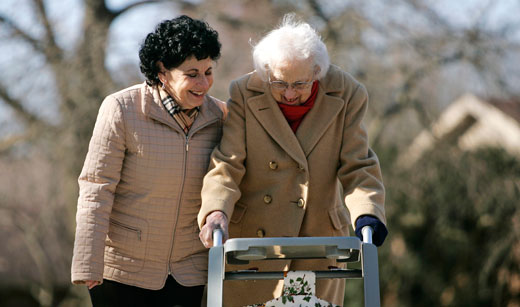
WASHINGTON (PAI) – Unions and their allies in civil rights, women’s rights, community and faith groups launched a new national campaign on July 12 to recruit millions of new givers of eldercare. The recruiting campaign is designed to improve and enhance those workers’ rights – including the right to organize – and ensure needed care for the coming millions of elderly clients.
The 700 delegates of Caring Across Generations (CAG) launched their drive with a congress in Washington, which preceded 15 other sessions to be held in 12 other cities nationwide in coming months. They also met on Capitol Hill with Sens. John Kerry, D-Mass., and Barbara Mikulski, D-Md., among others. Obama administration Labor Secretary Hilda Solis lent her voice to the drive.
The objective is to enhance community-based and home-based long-term care for the current 7.6 million elderly adults who need it and for the estimated one-fifth of the U.S. population that will need it by 2030.
Currently home-care workers are usually underpaid, often subject to bad working conditions are barred from organizing unless states give a sort of permission by setting up “employers” with whom they can negotiate and – thanks to a U.S. Supreme Court decision several years ago – don’t even qualify for the minimum wage or overtime.
“The CAG campaign will help baby boomers and their families meet care needs by realizing the ‘five fingers of the caring hand,’ including:
Creation of new, quality jobs in home care;
Labor standards and improved job quality for existing jobs and new jobs;
Training and career ladders for home care workers;
A new visa category and path to citizenship for care workers;
Support for individuals and families in need of support and care, including the creation of a matching registry and maintenance and expansion of funding streams,” the group said in its mission statement.
One of those funding streams may be the federal government, as CAG is telling Congress that home care is much less expensive, and much more healthy (both physically and psychologically) for the elderly than nursing-home or other institutional care.
“Now is the time to invest in home care. It will save money, help people to stay healthy longer, protect consumer choice, support working families, and ensure that a stable workforce of well-trained caregivers serves our seniors,” the group said.
It’ll also create jobs: CAG estimates that to deal with the growing number of senior citizens the U.S. will need 2 million more paid caregivers by 2016.
Supporters of the campaign include the Coalition of Labor Union Women, the National Consumers League, AFL-CIO, AFSCME, the Service Employees, Interfaith Worker Justice, American Rights at Work, the Asian-Pacific American Labor Alliance, Casa de Maryland, the Institute for Women’s Policy Research, the Labor Coalition for Civil and Human Rights, the NAACP, the National Day Laborer Organizing Network, the National Domestic Workers Alliance, the National Employment Law Project and the National Partnership for Women and Families.
Many of those groups – notably CLUW, AFSCME and SEIU – represent home care workers. Another on the list, the Alliance for Retired Americans, includes many people who are present or future candidates for home care.
Besides Solis, the Obama White House’s Initiative for Asian and Pacific Islanders also signed up for the new campaign.
“SEIU home care workers and consumer allies have led the fight to raise the standards for both direct caregivers and, more importantly, consumers of care,” union spokesman Richard Negri wrote in a statement. “This is why we linked arms with 600 other home care workers from around the country to be a part of the campaign launch.” SEIU members from Illinois, California, Indiana and Virginia attended the conference.
SEIU Health Care Chair Dr. L. Toni Lewis told conferees: “There are still states that skirt federal minimum wage laws, there are still home care workers that provide quality but have no access to affordable health care for themselves or their families, and there are still home care workers who cannot afford to get sick because it means they will not get paid. It may not happen this year, and it may not happen next year, but together, we are going to change this and make it right.”
Photo: The growing number of senior citizens in the U.S. will need 2 million more paid caregivers by 2016. (Jim Noelker/Dayton Daily News/AP)










